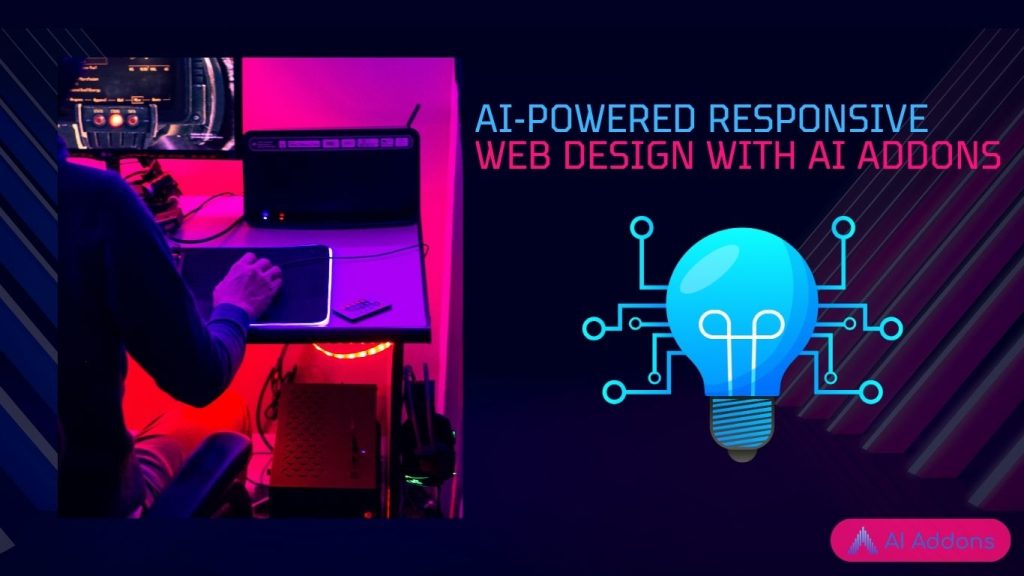A responsive website can accommodate any device, browser, or particular resolution without any layout or scrolling issues. As a result, your experiences across various operating systems and devices are seamless. Web designers ought to routinely use responsive web design. That’s where AI Addons comes into the scenario.
An approach to web design known as responsive web design enables a website to adjust to various screen sizes and devices. On desktops, laptops, tablets, and smartphones, it makes it possible for a website to look good and work properly. This implies that your audience may have a seamless and satisfying experience on your website regardless of their device.
Over time, the idea of responsive web design has expanded to encompass additional facets of web development, such as performance and accessibility. A responsive website loads quickly is accessible to all users, including those with disabilities, and looks excellent on various devices.
The fact that responsive web design has taken over as the industry standard for web development is an intriguing reality. This strategy is used by the majority of websites created today to guarantee that anyone, anywhere, at any time, can access them. Learning responsive web design as a novice web developer is crucial to staying on top of trends and building user-friendly, accessible websites.
So, responsive web design is the way to go if you want to make websites that look fantastic and function effectively on all devices!
What is a Responsive Design?
An approach to web design known as responsive design seeks to offer the best viewing and user experience across all devices and screen sizes. It entails developing a website layout that responds and adjusts to the platform, orientation, and screen size of the user’s device.
Simply defined, responsive design makes sure that a website can be efficiently read and utilized on any device, from a desktop computer to a mobile phone, without the need for zooming, panning, or horizontal scrolling. Flexible grids, fluid images, and responsive CSS media queries are used to do this, altering the website’s layout to fit the screen size of the device.
There are several advantages to responsive design. You can promote accessibility, deliver a smooth user experience across all devices, and optimize your website for search engines by building a responsive website. By removing the need to produce distinct websites for various devices, responsive design can also assist save website maintenance and development expenses.
What does responsive web design look like?
The layout, style, graphics, and other aspects of a responsive website can be the same as those of any other website, but they are modified to fit the screen size of the device being used to view it. Here are some illustrations of what responsive web design might resemble:
- On a desktop computer, a website may have a wide layout with a menu of options at the top and several content columns arranged side by side.
- The same website may have a different layout when accessed on a tablet, with the navigation menu reduced to a single hamburger menu symbol and the content columns stacked vertically for easier reading.
- For simpler navigation and engagement when viewed on a smartphone, the website may feature a single-column layout, larger typography, and larger buttons and links.
Other design components that improve the user experience may also be incorporated into responsive web design, such as touch-friendly buttons, optimized graphics, and the use of whitespace to improve reading.
The important thing to remember is that responsive web design modifies the website’s layout to make sure it appears and functions beautifully on all devices. In today’s digital age, when people visit websites from a multitude of devices, this strategy improves the website’s usability and accessibility.
How does responsive web design work?
In order to develop a website that adjusts to the screen size of the user’s device, responsive web design uses a variety of techniques like flexible layouts, fluid pictures, media queries, etc. Although it seems difficult, it’s really fairly easy!
More specifically, here’s how it functions:
- Flexible layouts: Responsive design uses flexible grids that adapt to the size of the user’s screen rather than fixed-width layouts. Instead of utilizing fixed pixels, this is accomplished by employing relative units of measurement, such as percentages.
- Fluid images: Fluid images, which scale up or down to fit the size of the user’s screen, are another component of responsive design. This makes sure that photographs always look fantastic on any device.
- Media Queries: Applying various styles and layouts to various screen sizes is done via media queries. As a result, the website’s layout, font, and other design aspects can be modified to offer the greatest user experience across all devices.
- Grid-view: A key element of responsive web design is the usage of grids. Each element of the page is placed within a grid that has been created by dividing the layout of a webpage into columns and rows. This makes it possible to utilize space more effectively and makes it simpler to design a layout that adapts to various screen sizes.
- Orientation media feature: Depending on the orientation of the device being used, different styles and layouts can be applied. When a user turns their phone from portrait to landscape mode, for instance, you might wish to display a new layout.
- Flexible media: To ensure that media components like photos and movies scale properly to the size of the device screen, flexible media uses relative units of measurement, such as percentages or ems. By doing this, problems with media items looking excessively big or small on specific devices are avoided.
As a result, the website looks fantastic and functions well on all platforms, including desktop PCs and mobile phones. Instead of needing to create numerous websites for various devices, web developers may save time and effort by adopting responsive design to create one website that functions on all devices.
It’s fascinating to observe how responsive design has transformed web development and made it simpler for programmers to produce websites that are effective, accessible, and user-friendly. You can make sure that your website appears fantastic on any device using the responsive design without sacrificing style or functionality. Both developers and users benefit from it.
Web designers can create websites that are extremely functional on a variety of devices and aesthetically pleasing by combining these strategies. Today, everybody working in web development must be proficient in responsive web design due to the ongoing increase in the use of mobile devices and tablets.
Advantages of using responsive web design
Using a responsive web design will help you make websites that are more user-friendly, captivating, and accessible. Here are some benefits:
- Better user experience: By making your website responsive, you can make sure that it looks amazing on any device and provide users with an easier time navigating, reading, and interacting with your information. This improves user experience and keeps visitors on your site longer.
- Increased reach: A bigger audience may be reached thanks to responsive design, as more people are using mobile devices to access the internet. You can draw in more users and keep them around longer by offering a consistent user experience across all devices.
- Lower development costs: Responsive design enables you to create a single website that functions for all devices rather than having to create separate websites for desktop and mobile. This reduces the need for maintenance and upgrades, as well as the expense of development.
- Increased SEO: Responsive design can also aid in raising your website’s placement in search results. In addition to making it simpler for search engines to index and rank your content, Google has said that responsive websites are preferable.
- Responsive design allows you to future-proof your website so that it will be compatible with all devices and screen sizes. Your website will be future-proofed as a result, saving you from having to constantly revamp it whenever a new gadget is introduced.
AI-powered Responsive Web Design with AI AddOns
Responsive web design plays a crucial role in ensuring that websites look and function flawlessly across different devices and screen sizes. With the emergence of artificial intelligence (AI) and AI addons, the process of creating responsive web designs has become even more efficient and effective.
- Understanding Responsive Web Design: Responsive web design involves creating websites that adapt their layout, content, and functionality based on the device and screen size of the user. Traditionally, designers manually coded responsive designs, but AI-powered solutions and AI addons have simplified and streamlined the process.
- AI-powered Device Detection and Adaptation: AI-powered device detection enables websites to automatically recognize the user’s device and adjust the design accordingly. AI algorithms analyze device-specific data, such as screen size, resolution, and capabilities, to optimize the layout, font sizes, images, and navigation for the best user experience.
- AI-powered Content Adaptation and Personalization: AI addons can enhance responsive web design by analyzing user preferences, behavior, and contextual data to personalize the content displayed on different devices. Through machine learning and natural language processing, AI can dynamically adapt and customize the website’s content, recommendations, and calls to action based on user profiles and interactions.
- AI-driven Performance Optimization: AI addons can optimize website performance by automating tasks such as image compression, lazy loading, and caching based on the user’s device and network conditions. These AI-powered optimizations ensure that websites load quickly and efficiently, regardless of the device or network speed.
- Voice User Interface and AI: AI addons enable the integration of voice user interfaces into responsive web designs, allowing users to interact with websites using voice commands. AI-powered natural language processing understands and responds to user queries, enabling hands-free and intuitive interactions across devices.
- Privacy and Ethical Considerations: While leveraging AI for responsive web design brings numerous benefits, it is essential to prioritize user privacy and adhere to ethical guidelines. Websites must ensure transparent data usage, obtain user consent, and comply with data protection regulations to maintain trust and respect user privacy.
- Create a CTA that is simple to find: The goal here is to create a CTA that is simple to find. It should be undetectable to the user so they don’t perceive it as being deliberately targeted. Adding a CTA is simpler when creating desktop apps. On a tablet or phone, though, you must arrange it properly so that it may be clicked. However, it shouldn’t be so big that it obscures other crucial site components.
Conclusion
Responsive web design will become a crucial resource for companies of all sizes as the use of mobile devices rises. You can future-proof your website and make it compatible with any device by implementing a responsive design.
AI-powered responsive web design, combined with AI addons, empowers designers to create seamless multi-device experiences that adapt to users’ preferences, devices, and behaviors. By automating device detection, personalizing content, optimizing performance, integrating voice interfaces, and leveraging AI-driven A/B testing, websites can deliver exceptional user experiences.
However, it is crucial to consider privacy and ethical considerations, emphasizing transparency and user consent. As AI continues to advance, the future of AI-powered responsive web design holds even more exciting possibilities, ensuring that websites provide optimal experiences across an increasingly diverse range of devices and user contexts.


